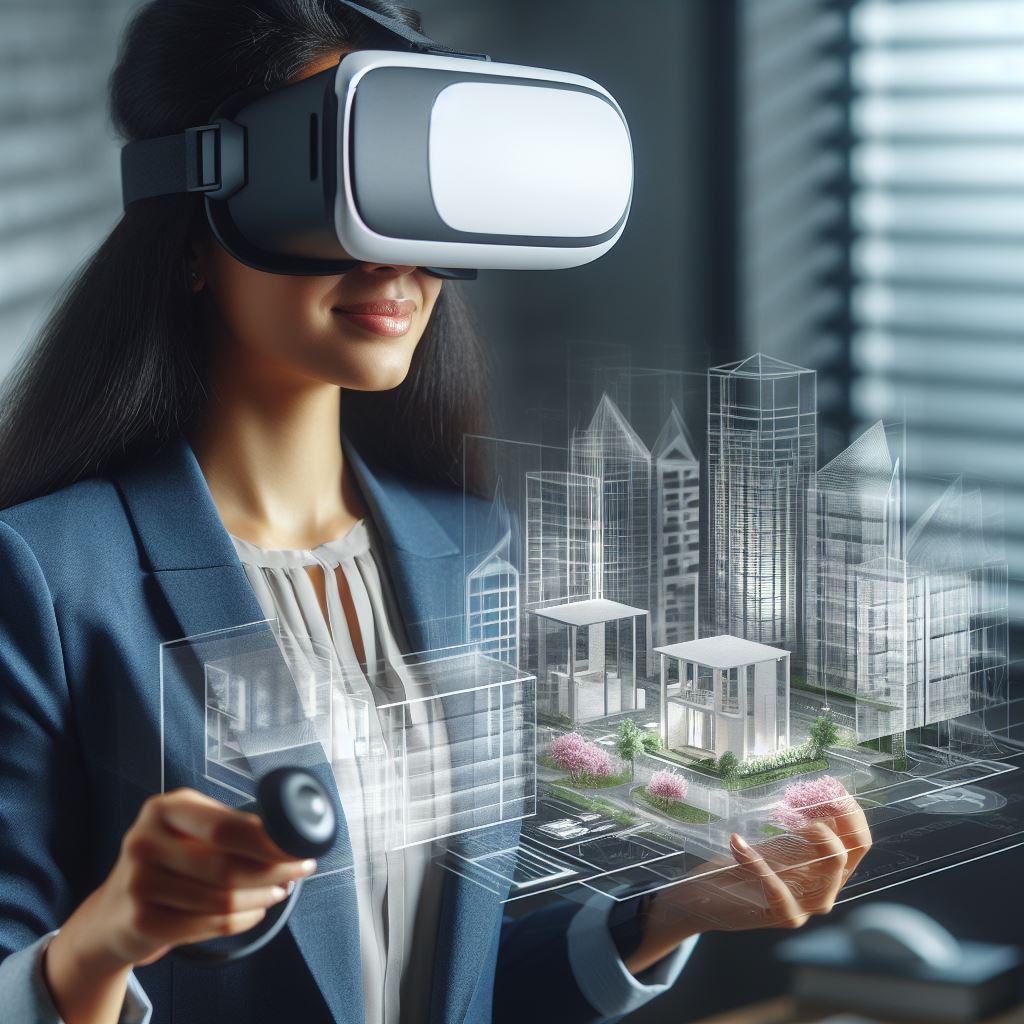Introduction
Virtual reality (VR) has completely transformed the architectural industry by introducing immersive virtual experiences.
With the help of VR, architects and designers can now visualize architectural plans like never before.
This technology has opened up a whole new world of possibilities and benefits for the industry.
One of the key benefits of VR in architecture is the ability to create realistic and interactive virtual environments.
Architects can now walk through their designs in a virtual space, giving them a better understanding of the spatial relationships and proportions.
They can also experience the lighting conditions and material textures, helping them make informed design decisions.
Furthermore, VR enables architects to effectively communicate their ideas to clients and stakeholders.
Instead of presenting static 2D drawings or models, architects can now showcase their designs in a dynamic and interactive manner.
This enhances the communication process and ensures that everyone involved has a clear understanding of the design intent.
VR also allows for efficient collaboration among team members. Architects, engineers, and clients can collaborate in real-time within a virtual environment.
They can review and discuss the design, make changes, and explore different options together.
This not only saves time but also improves the overall quality of the design process.
In essence, VR has brought about significant transformations in the architectural industry.
Its immersive and interactive nature has revolutionized the way architects conceptualize and communicate their designs.
With the potential benefits that VR offers, it is clear that it has become an essential tool in the field of architecture.
What is VR?
Virtual Reality (VR) and its basic principles
Virtual Reality, or VR, refers to a computer-generated environment that can mimic real-world experiences.
To create a realistic VR experience, three primary principles are followed.
First, the user must be fully immersed in the virtual environment, which is achieved through the use of specialized hardware such as headsets and gloves.
Second, the virtual environment must be interactive, allowing users to engage with and manipulate objects within it.
Lastly, the VR system must provide users with a sense of presence, making them feel as if they are truly present in the virtual world.
How VR creates a simulated environment
VR technology utilizes a combination of computer graphics, sensors, and tracking systems to create a simulated environment.
The core component of VR is the headset, which consists of a display that is worn on the user’s head, covering their eyes and ears.
The display presents a stereoscopic view, with each eye seeing a slightly different image to create depth perception.
Sensors in the headset track the user’s head movements, allowing the virtual environment to adjust accordingly.
Additional input devices, such as handheld controllers or gloves, enable users to interact with objects and navigate the virtual world.
All these elements work together to create a seamless and immersive simulated environment.
Evolution of VR technology and its growing availability
VR technology has come a long way since its inception, with significant advancements in hardware and software.
Initially, VR was limited to high-end systems used primarily for military training and research purposes.
However, with the increasing accessibility of hardware components and advancements in computer processing power, VR has become more affordable and widely available.
Today, there are various VR platforms and devices on the market, catering to different needs and budgets.
Popular VR systems include Oculus Rift, HTC Vive, and PlayStation VR, each offering unique features and experiences.
Furthermore, VR applications have expanded beyond gaming and entertainment, finding utility in fields such as architecture, medicine, and education.
Architects, for example, can use VR to transform their plans into immersive 3D experiences, allowing clients to visualize spaces before they are built.
The growing availability of VR technology has also led to an increased development of VR content, including games, simulations, and educational experiences.
In fact, Virtual Reality is a computer-generated environment that immerses users in a simulated world.
It employs advanced hardware and software to create a realistic and interactive experience.
Over time, VR technology has become more accessible and widespread, finding applications in various industries.
As the technology continues to advance, VR has the potential to revolutionize not only architectural plans but also other aspects of our daily lives.
Read: Machine Learning: Changing Property Valuations
Application of VR in Architectural Plans
Present the use of VR in the design phase of architectural plans
Virtual Reality (VR) has revolutionized the architectural industry by transforming the way architectural plans are designed, constructed, and marketed.
In the design phase, VR enables architects to explore various design concepts in virtual space, fostering creativity and innovation.
Additionally, it facilitates improved collaboration and communication between clients and architects, resulting in better project outcomes.
Utilization of VR during the construction phase
During the construction phase, VR plays a vital role in detecting potential design flaws or clashes before construction begins.
By identifying and resolving these issues early, VR helps save time, money, and resources.
Furthermore, virtual walkthroughs using VR streamline the project approval and permits process by providing stakeholders with a comprehensive understanding of the proposed project.
Incorporation of VR in marketing architectural projects
In marketing architectural projects, VR offers immersive virtual tours, allowing potential buyers or investors to experience the property without physically visiting.
This not only saves time but also widens the reach of architectural firms.
Moreover, interactive VR presentations showcase the full potential of a property, enhancing the marketing efforts and improving client engagement and satisfaction.
In short, the application of VR in architectural plans has revolutionized the industry, offering architects and clients a range of benefits from enhanced design exploration and collaboration to streamlined construction processes and improved marketing strategies.
As technology continues to advance, VR is expected to play an even more significant role in the future of architecture.
Read: Enhancing Customer Service with AI in Realty
Advantages and Impact of VR on Architectural Plans
Enhanced visualization and spatial understanding
VR technology allows architects and clients to immerse themselves in a virtual representation of a building, providing a detailed and realistic experience.
The ability to walk through spaces, observe materials, and assess the scale helps in understanding the design intent better.
Improved decision-making and problem-solving
With VR, architects can identify design flaws and potential issues at an early stage, facilitating better decision-making.
They can test different design concepts and modify them in real-time, leading to more efficient problem-solving.
Time and cost savings in design iterations and rework
Virtual reality enables architects to streamline their design process by reducing the need for physical models and multiple iterations.
With VR, they can visualize and make modifications digitally, saving time and resources compared to traditional methods.
Increased client satisfaction and engagement
VR technology enables clients to have a better understanding of the proposed designs.
They can actively participate in the design process by providing feedback and experiencing the space before it is built.
This increases client satisfaction and reduces the chances of disappointment or surprises during the construction phase.
Potential for sustainable design and testing through VR simulations
Virtual reality allows architects to simulate and analyze different environmental conditions, such as lighting, airflow, and energy use.
By testing sustainable design strategies virtually, architects can optimize energy efficiency and reduce the environmental impact of a building.
Disruption of traditional architectural practices and industry growth
VR technology has the potential to disrupt traditional architectural practices by revolutionizing the way designs are presented and communicated.
Architects who embrace VR can differentiate themselves in the industry, attract more clients, and stay ahead of competitors.
The adoption of VR in architecture is expected to drive industry growth and create new opportunities for architects and related professionals.
In general, virtual reality offers numerous advantages and has a significant impact on architectural plans.
From enhanced visualization and spatial understanding to improved decision-making and problem-solving, VR transforms the design process.
It also brings time and cost savings, increases client satisfaction, and opens up possibilities for sustainable design testing.
Furthermore, VR has the potential to disrupt traditional practices and contribute to the growth of the architectural industry.
Architects who embrace VR technology can revolutionize their profession and stay ahead in an increasingly competitive market.
Read: AI in Real Estate: Transforming Market Analysis

Future Trends and Challenges in VR for Architectural Plans
Emerging technologies like augmented reality (AR) in architectural design
Augmented reality (AR) is an emerging technology that combines virtual elements with the real-world environment.
It has the potential to revolutionize architectural design by allowing architects to overlay virtual designs onto physical spaces.
Potential challenges of VR implementation in the industry
- Cost and accessibility limitations: VR technology can be expensive to implement, making it inaccessible for smaller firms or individual architects.
- Learning curve for architects and professionals: Architects will need to acquire the necessary skills to effectively use VR tools, which may pose a challenge.
Future advancements and their impact on architectural planning
Future advancements in VR technology are expected to have a significant impact on architectural planning:
- Improved visualization: VR will continue to enhance architects’ ability to visualize and present designs, leading to better client understanding and decision-making.
- Enhanced collaboration: VR will enable architects from different locations to collaborate in real-time, eliminating geographical barriers and improving the design process.
- Virtual site visits: Architects will be able to conduct virtual site visits, allowing them to explore and analyze the surrounding environment without physically being present.
- Sustainable design: VR can assist architects in creating more sustainable designs by simulating energy usage, optimizing building materials, and evaluating environmental impact.
- Interactive client involvement: VR will enable clients to immerse themselves in the virtual environment, experiencing the design in a more interactive and engaging manner.
- Efficient design iterations: With VR, architects can quickly iterate and modify designs, saving time and reducing costly mistakes.
- Real-time feedback: VR will provide architects with instant feedback on design choices, allowing them to make adjustments on the spot.
As these advancements continue, the use of VR in architectural planning will become more widespread, ultimately transforming the industry.
Read: Navigating Real Estate Regulations with Blockchain
Conclusion
The transformative potential of Virtual Reality (VR) in architectural plans cannot be overstated.
VR technology has ushered in a new era of design exploration and communication, allowing architects to immerse themselves and their clients in virtual spaces with unprecedented realism.
By providing immersive experiences that go beyond traditional 2D drawings or even 3D models, VR enables architects to convey their design visions more effectively, leading to better-informed decision-making and greater client satisfaction.
Embracing technological innovations like VR is not just advantageous but essential for architects who wish to remain competitive in today’s fast-paced industry.
The adoption of VR demonstrates a commitment to innovation, creativity, and efficiency, qualities that are highly valued in an increasingly digital world.
Architects who harness the power of VR gain a significant edge over their peers, not only in terms of design capabilities but also in their ability to attract and retain clients who seek cutting-edge solutions.
Therefore, I strongly encourage readers to explore VR solutions for their architectural projects.
Whether it’s using VR for design visualization, client presentations, or virtual walkthroughs, integrating VR into the architectural workflow can yield numerous benefits.
By embracing VR, architects can streamline the design process, reduce errors and rework, and ultimately deliver more compelling and immersive architectural experiences.
Moreover, investing in VR now positions architects at the forefront of technology, ensuring their relevance and competitiveness in the evolving architectural landscape.
So, don’t hesitate—dive into the world of VR and unlock the full potential of your architectural projects today.




